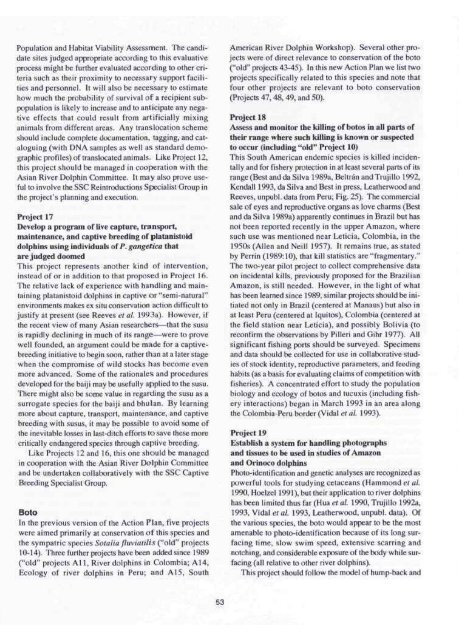Dolphins, Porpoises, and Whales - IUCN
Dolphins, Porpoises, and Whales - IUCN
Dolphins, Porpoises, and Whales - IUCN
Create successful ePaper yourself
Turn your PDF publications into a flip-book with our unique Google optimized e-Paper software.
Population <strong>and</strong> Habitat Viability Assessment. The c<strong>and</strong>idate<br />
sites judged appropriate according to this evaluative<br />
process might be further evaluated according to other criteria<br />
such as their proximity to necessary support facilities<br />
<strong>and</strong> personnel. It will also be necessary to estimate<br />
how much the probability of survival of a recipient subpopulation<br />
is likely to increase <strong>and</strong> to anticipate any negative<br />
effects that could result from artificially mixing<br />
animals from different areas. Any translocation scheme<br />
should include complete documentation, tagging, <strong>and</strong> cataloguing<br />
(with DNA samples as well as st<strong>and</strong>ard demographic<br />
profiles) of translocated animals. Like Project 12,<br />
this project should be managed in cooperation with the<br />
Asian River Dolphin Committee. It may also prove useful<br />
to involve the SSC Reintroductions Specialist Group in<br />
the project's planning <strong>and</strong> execution.<br />
Project 17<br />
Develop a program of live capture, transport,<br />
maintenance, <strong>and</strong> captive breeding of platanistoid<br />
dolphins using individuals of P. gangetica that<br />
are judged doomed<br />
This project represents another kind of intervention,<br />
instead of or in addition to that proposed in Project 16.<br />
The relative lack of experience with h<strong>and</strong>ling <strong>and</strong> maintaining<br />
platanistoid dolphins in captive or "semi-natural"<br />
environments makes ex situ conservation action difficult to<br />
justify at present (see Reeves et al. 1993a). However, if<br />
the recent view of many Asian researchers—that the susu<br />
is rapidly declining in much of its range—were to prove<br />
well founded, an argument could be made for a captivebreeding<br />
initiative to begin soon, rather than at a later stage<br />
when the compromise of wild stocks has become even<br />
more advanced. Some of the rationales <strong>and</strong> procedures<br />
developed for the baiji may be usefully applied to the susu.<br />
There might also be some value in regarding the susu as a<br />
surrogate species for the baiji <strong>and</strong> bhulan. By learning<br />
more about capture, transport, maintenance, <strong>and</strong> captive<br />
breeding with susus, it may be possible to avoid some of<br />
the inevitable losses in last-ditch efforts to save these more<br />
critically endangered species through captive breeding.<br />
Like Projects 12 <strong>and</strong> 16, this one should be managed<br />
in cooperation with the Asian River Dolphin Committee<br />
<strong>and</strong> be undertaken collaboratively with the SSC Captive<br />
Breeding Specialist Group.<br />
Boto<br />
In the previous version of the Action Plan, five projects<br />
were aimed primarily at conservation of this species <strong>and</strong><br />
the sympatric species Sotalia fluviatilis ("old" projects<br />
10-14). Three further projects have been added since 1989<br />
("old" projects All, River dolphins in Colombia; A14,<br />
Ecology of river dolphins in Peru; <strong>and</strong> A15, South<br />
S3<br />
American River Dolphin Workshop). Several other projects<br />
were of direct relevance to conservation of the boto<br />
("old" projects 43-45). In this new Action Plan we list two<br />
projects specifically related to this species <strong>and</strong> note that<br />
four other projects are relevant to boto conservation<br />
(Projects 47, 48, 49, <strong>and</strong> 50).<br />
Project 18<br />
Assess <strong>and</strong> monitor the killing of botos in all parts of<br />
their range where such killing is known or suspected<br />
to occur (including "old" Project 10)<br />
This South American endemic species is killed incidentally<br />
<strong>and</strong> for fishery protection in at least several parts of its<br />
range (Best <strong>and</strong> da Silva 1989a, Beltran <strong>and</strong> Trujillo 1992,<br />
Kendall 1993, da Silva <strong>and</strong> Best in press, Leatherwood <strong>and</strong><br />
Reeves, unpubl. data from Peru; Fig. 25). The commercial<br />
sale of eyes <strong>and</strong> reproductive organs as love charms (Best<br />
<strong>and</strong> da Silva 1989a) apparently continues in Brazil but has<br />
not been reported recently in the upper Amazon, where<br />
such use was mentioned near Leticia, Colombia, in the<br />
1950s (Allen <strong>and</strong> Neill 1957). It remains true, as stated<br />
by Perrin (1989:10), that kill statistics are "fragmentary."<br />
The two-year pilot project to collect comprehensive data<br />
on incidental kills, previously proposed for the Brazilian<br />
Amazon, is still needed. However, in the light of what<br />
has been learned since 1989, similar projects should be initiated<br />
not only in Brazil (centered at Manaus) but also in<br />
at least Peru (centered at Iquitos), Colombia (centered at<br />
the field station near Leticia), <strong>and</strong> possibly Bolivia (to<br />
reconfirm the observations by Pilleri <strong>and</strong> Gihr 1977). All<br />
significant fishing ports should be surveyed. Specimens<br />
<strong>and</strong> data should be collected for use in collaborative studies<br />
of stock identity, reproductive parameters, <strong>and</strong> feeding<br />
habits (as a basis for evaluating claims of competition with<br />
fisheries). A concentrated effort to study the population<br />
biology <strong>and</strong> ecology of botos <strong>and</strong> tucuxis (including fishery<br />
interactions) began in March 1993 in an area along<br />
the Colombia-Peru border (Vidal et al. 1993).<br />
Project 19<br />
Establish a system for h<strong>and</strong>ling photographs<br />
<strong>and</strong> tissues to be used in studies of Amazon<br />
<strong>and</strong> Orinoco dolphins<br />
Photo-identification <strong>and</strong> genetic analyses are recognized as<br />
powerful tools for studying cetaceans (Hammond et al.<br />
1990, Hoelzel 1991), but their application to river dolphins<br />
has been limited thus far (Hua et al. 1990, Trujillo 1992a,<br />
1993, Vidal et al. 1993, Leatherwood, unpubl. data). Of<br />
the various species, the boto would appear to be the most<br />
amenable to photo-identification because of its long surfacing<br />
time, slow swim speed, extensive scarring <strong>and</strong><br />
notching, <strong>and</strong> considerable exposure of the body while surfacing<br />
(all relative to other river dolphins).<br />
This project should follow the model of hump-back <strong>and</strong>

















